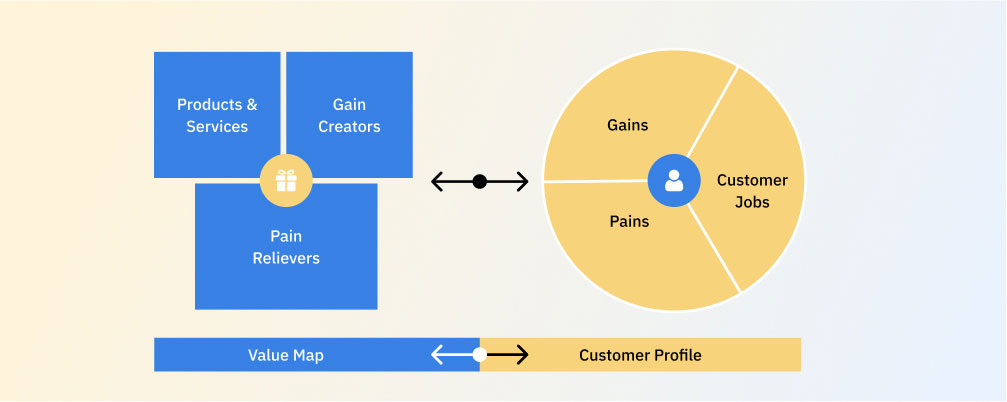What is a Product Value Proposition and How to Create One
November 9, 2023 | Read Time : 3 mins
Table of Contents
What is a Product Value Proposition?
Your Product Value Proposition is a clear and concise statement that explains why customers should choose your product or service over the competition. It should highlight your product’s unique benefits and how it can solve the customer’s problems or meet their needs.
A well-defined value proposition is essential for attracting and retaining customers. It helps you to:
- Stand out from the competition: In today’s crowded marketplace, differentiating your product or service is more important than ever. A strong value proposition can help you to do just that by clearly articulating what makes your offering unique and valuable.
- Attract your target audience: When you understand your target audience’s needs and wants, you can tailor your value proposition to speak directly to them. This will help you to attract the right kind of customers and build a loyal following.
- Increase conversions: A compelling value proposition can help you increase conversions by convincing customers that your product or service is the best solution for their needs.
Importance of a Strong Value Proposition
A strong value proposition is essential for any product or service that wants to be successful. It helps you to:
- Attract new customers: A clear and concise value proposition will make it easier for potential customers to understand what your product or service does and how it can benefit them. This can lead to more website visitors, leads, and sales.
- Increase customer loyalty: A value proposition that resonates with your target audience will help to increase customer loyalty. When customers feel like they are getting value for their money, they are likelier to continue buying from you and recommend you to others.
- Boost sales: A strong value proposition can help you boost sales by making it more persuasive for customers to purchase your product or service.
Understanding Your Audience
Understanding your target audience is the first step to crafting a compelling value proposition. What are their needs and wants? What problems are they trying to solve? What are their pain points? Once you understand your audience well, you can tailor your value proposition to speak directly to them.
Here are a few tips for understanding your target audience:
- Conduct market research: There are several ways to conduct market research, such as surveys, interviews, and focus groups. This research can help you to learn more about your target audience’s demographics, psychographics, and buying habits.
- Analyze your customer data: If you have a customer database, you can analyze it to learn more about your existing customers. What products or services do they buy? What are their pain points? What do they like and dislike about your company?
- Talk to your sales team: Your sales team is in constant contact with customers, so they can provide valuable insights into their needs and wants. Ask them what customers are saying about your product or service and what challenges they are facing.
Identifying Unique Selling Points (USPs)
Once you understand your target audience, you must identify your product or service’s unique selling points (USPs). What makes your offering different and better than the competition? What unique benefits does it offer?
Here are a few tips for identifying your USPs:
- List all of your product or service’s features and benefits. Then, start to cross out any features or benefits that your competitors also offer. The features and benefits that are left over are your USPs.
- Think about what makes your company unique. What are your strengths? What are your values? What is your mission? What sets you apart from the competition?
- Talk to your customers. Ask them what they like about your product or service. What makes it stand out from the competition?
Crafting a Compelling Value Proposition
Once you have identified your USPs, you need to craft a compelling value proposition that articulates the benefits of your product or service clearly and concisely.
Here are a few tips for crafting a compelling value proposition:
- Focus on the customer: Your value proposition should be about how your product or service can benefit them. Avoid using technical jargon or buzzwords.
- Be specific: Don’t just say that your product is “great” or “revolutionary.” Be specific about its benefits and how it can solve the customer’s problems.
- Use strong action verbs: Use strong action verbs to make your value proposition more persuasive. For example, instead of saying, “Our product can help you to lose weight,” say, “Lose weight quickly and easily with our product.”
- Make it unique: Your value proposition should be unique to your product or service. Avoid making generic claims that any competitor could make.

Real-life Examples
Here are some examples of companies with exemplary value propositions:
- Apple: “Apple designs beautiful, user-friendly products for everyday life. We believe technology should be powerful enough to be useful, yet simple enough to be enjoyable.”
- Amazon: “Amazon is guided by four principles: customer obsession rather than competitor focus, passion for invention, commitment to operational excellence, and long-term thinking.”
- Tesla: “Tesla’s mission is to accelerate the world’s transition to sustainable energy.”
These value propositions are clear, concise, and focused on the customer. They also highlight the unique benefits that these companies offer.
1. Testing and iterating
Once you have crafted a value proposition, testing it to ensure it resonates with your target audience is important. You can do this by conducting surveys, interviews, or focus groups.
Once you have your target audience’s feedback, you can iterate on your value proposition. This process may involve changing your value proposition’s language, tone, or content.
2. Avoiding common pitfalls
Here are a few common pitfalls to avoid when crafting your value proposition:
- Making vague claims: Avoid making vague claims that any competitor could make. Instead, be specific about the benefits that your product or service offers.
- Focusing on features instead of benefits: Customers don’t care about your product’s features; they care about the benefits they offer. Make sure that your value proposition focuses on the benefits of your product or service.
- Using technical jargon: Avoid using technical jargon or buzzwords your target audience may not understand. Instead, use plain language that is easy to understand.
- Making it too long: Your value proposition should be clear and concise. Avoid making it too long or complicated.
3. Adapting to market changes
The market is constantly changing, so adapting your value proposition accordingly is important. Regularly review your value proposition to make sure that it is still relevant to your target audience and that it highlights the unique benefits of your product or service.
4. Measuring the impact of your value proposition
There are several ways to measure the impact of your value proposition. Here are a few key metrics to track:
- Website traffic: Track the traffic to your website before and after launching your new value proposition. If you see increased traffic, this is a good sign that your value proposition resonates with people.
- Lead generation: Track the leads you generate before and after launching your new value proposition. If you see an increase in leads, this is another good sign that your value proposition is effective.
- Conversion rates: Track your conversion rates before and after launching your new value proposition. If you see an increase in conversion rates, your value proposition is persuading more people to buy your product or service.
Additional Tips
We encourage you to take some time to refine your Product Value Proposition. Ensure it is clear, concise, and focused on the customer. Test your value proposition with your target audience to ensure it resonates with them. And regularly review your value proposition to ensure it is still relevant to the market.
Here are a few additional tips for crafting a compelling value proposition:
- Use storytelling: People are likelier to connect with stories than facts and figures. Try using storytelling in your value proposition to explain how your product or service can solve the customer’s problems or improve their lives.
- Use social proof: Social proof is a powerful psychological principle that states that people are more likely to do something if they see others doing it. Try to incorporate social proof into your value proposition by sharing testimonials from satisfied customers or highlighting the number of people using your product or service.
- Make it easy to act: Once you have convinced the customer that your product or service is the right solution, make it easy for them to act. Include a clear call to action in your value proposition, such as “Sign up for a free trial” or “Buy now.”
By following these tips, you can create a value proposition to help you achieve your business goals.






